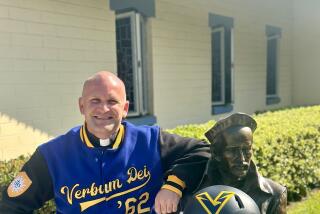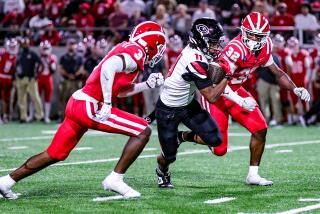Alumni Go to the Head of the Class
Walking past Room 607, Merritt Hemenway slowed his gait and narrowed his brows. Something about this seemingly mundane spot had diverted his attention.
He paused. It was morning at Bishop Amat Memorial High School near La Puente, where Hemenway is the principal.
For just a moment, he was a high school senior again. It was Nov. 22, 1963, and he was in third-period physics. Msgr. Thomas Kiefer, the school’s founding principal, had just gone on the classroom intercom to announce that President Kennedy had been shot in Dallas. Soon everyone could hear the student body president’s voice, leading the school in the rosary.
Just as quickly, Hemenway snapped back to the present.
“Ah, it brings back memories,” he said.
This sort of time travel happens frequently at Bishop Amat, where nearly one third of the staff -- 23 of the 80 teachers and administrators -- are alumni.
Dave Caro, the band director, sees his younger, slimmer self playing the piano in student theatrical productions.
When dean of juniors and performance groups moderator Sue Marquez admonishes girls for dress code violations, she remembers being upbraided herself for wearing a too-short skirt.
At football games, business teacher Tim Murphy’s body is in the stands, but his mind sometimes dashes onto the field, back in the uniform of the Bishop Amat Lancers.
English teacher Emily Jones, walking down the hall, feels a little zing of nostalgia when she looks up to see that she is standing in front of her old locker.
This is a place where, at any given moment of any given day, someone, somewhere on campus is experiencing deja vu.
“I figure someday I’ll graduate,” said Murphy, who did, in fact, graduate in the class of 1976, “but I’m in no hurry for it.”
At Bishop Amat, they seem to take the opening lines of the school song seriously:
Hail Amat High School
We’ll remember you,
Dear alma mater
We’re steadfast, loyal and true.
Bishop Amat isn’t unique. Many public and private high schools and quite a few elementary and middle schools have teachers or administrators who are also alumni.
It’s almost a natural progression in small communities, where there may not be many choices for would-be teachers. Even in large metropolitan areas, where teachers could wind up at any of hundreds of schools, it’s common for them to drift back to the places they know best.
Garfield High School in East Los Angeles, with a staff of 180, has roughly 60 teachers who are alumni. Cleveland High School in Reseda has 15 alumni on the staff and San Fernando High School in San Fernando has 14.
Bishop Montgomery High School in Torrance has 14 alumni among 84 teachers and administrators, and Mater Dei High School in Santa Ana has 26 alumni among 180 faculty and staff.
There’s something slightly romantic about the idea: Who hasn’t wanted another crack at high school? But it can also be strange to teach at the school where one sweated over grades, felt the first blush of love, challenged authority or schemed to evade it.
Like many of the alumni at Bishop Amat, Nichol Davis (class of ‘98) found it hard at first to address her former teachers by their first names. Even now, in her position as dean of freshmen, she finds that there are colleagues whom she can call only “Mr.” or “Mrs.”
Her classmate, Gabe Escovar, found himself in a different sort of awkward position when he returned as an English teacher. He quickly ran into the one teacher most likely to remember him as a disciplinary problem.
“I said, ‘I’m Gabriel Escovar, and you taught me geometry in ’96 or whatever.’ And she said, ‘Ah,’ and she paused. And she said, ‘Mr. Escovar. My, how you’ve changed.’
“To this day,” he added, “that’s all she’s said to me.”
The older teacher’s observation could apply to all of the alumni teachers, who quickly learn just how much they have changed.
Asked if they dream about the school, most of the alumni said yes, adding that in their dreams, they are always teachers, not students. They don’t dream about forgetting to study for tests. They dream about forgetting to prepare for lessons.
Bishop Amat, which is run by the Los Angeles Archdiocese, is tucked into an unremarkable residential neighborhood just outside the city limits of La Puente, a place that sprang to life in the 1950s and is the quintessence of Southern California ranch house suburbia.
The town motto -- “Where the past meets the future” -- applies rather neatly to the school.
From the outside, Bishop Amat looks like a fairly generic suburban American school -- if one overlooks the ubiquitous crosses and religious statuary that proclaim its Roman Catholic affiliation.
It draws from the immediate area and from a cluster of surrounding communities in the southeastern San Gabriel Valley: Covina, West Covina, Baldwin Park, El Monte.
Typical parents are construction workers, police officers, teachers, people with a foothold on the middle class but few airs of affluence. The tuition, around $5,000 a year, is a stretch for many.
The school is two-thirds Latino, including many Mexican Americans with deep roots in Southern California -- families that stretch back four, five, six generations. The rest of the students are mostly whites, blacks and Filipinos.
At a time when many Catholic schools are struggling to maintain enrollment and filling seats with children of other faiths, Bishop Amat remains almost 90% Catholic.
And although it is perhaps best known as an athletic powerhouse -- past football heroes have included Pat Haden, John McKay Jr. and John Sciarra -- it also sends more than 90% of its students to college.
Many are the first in their family to go.
Maria Dolores Ramos graduated from Bishop Amat in 1966, back when a blue line ran through campus, separating boys from girls, and most of the faculty members were priests and nuns. (It has only one priest and one nun today.)
Early in her senior year, a nun, Sister Declan, asked where Ramos planned to go to college. No one in her family had ever gone to college, nor had it ever been discussed.
“I said, ‘I don’t think I am going to college,’ ” she recalled. “And Sister Declan said, ‘No, you are going to college.’ ”
It wasn’t a suggestion. It was a decree.
Ramos, now Maria Gover, told this story in her office at Bishop Amat, where she is an assistant principal. She has a bright smile and dark, penetrating eyes -- the same smile, the same eyes that radiate intelligence and shy excitement in her senior yearbook picture.
On orders from Sister Declan, she took the SAT and did well enough to be admitted to UC Santa Barbara on a full scholarship. She graduated with a degree in English and eventually got a master’s degree in education.
Today, one of her daughters has a master’s degree; another is in a postgraduate program at Oxford University. Both are Bishop Amat graduates, as is a son, who is in the Air Force.
“It all comes from that day that Sister Declan said, ‘You’re going to college,’ ” Gover said, a sense of wonder in her voice. “Doesn’t it? I think so.”
In “Catholic Schools and the Common Good,” authors Anthony S. Bryk, Valerie E. Lee and Peter B. Holland, write: “Anyone who has spent time inside Catholic schools finds it hard to ignore the distinctive atmosphere in many of them.... The description used by both students and adults -- ‘we are a community’ -- captures the essence of the schools’ social organization.”
It is a description heard often at Bishop Amat.
As many public schools are converting to smaller, more personal units, Bishop Amat appears to already be there. (With slightly fewer than 1,500 students, it is about half the size of a typical public high school in Southern California.)
Part of what makes the school a community is its foundation in religion. Apart from the obvious -- classes that begin in prayer, school-wide Mass, religion courses -- Catholicism undergirds everything at the school, from its approach to science to its modest dress code to its attitudes about popular culture and morality.
“It’s so well integrated into our school that sometimes I think the kids don’t even notice,” said Murphy, the business teacher.
Beyond that, there is something almost familial about relationships at Bishop Amat.
Murphy, who grew up in Alhambra, is one of three siblings to have attended Bishop Amat. He met his wife there; their son graduated from the school in 2002 after playing football alongside teacher Sue Marquez’ son.
Marquez, who grew up in Temple City, was one of three sisters to attend Bishop Amat; she met her future husband there and, besides their son, they also have a daughter, who is a senior.
Caro, the school’s drum major when Marquez was a cheerleader, has two children attending Bishop Amat, including one who is a classmate of Marquez’s daughter.
Bishop Amat alumni give various reasons for returning. They fondly recall their high school years.
They wanted to teach but may have lacked the credential that is required to work in public schools. They called a former teacher for advice about a teaching career and heard about an opening at Bishop Amat.
And many were drawn back by Hemenway.
A chipper, precise man, Hemenway graduated from Bishop Amat in 1964 and has spent most of the intervening years there as either a teacher or principal.
He wears a neat gray beard that gives his face some superficial resemblance to that of his distant relative, Ernest Hemingway.
“I remember when I was first hired,” Hemenway said. “Msgr. Kiefer
“And so ... 13 years later when I became principal, I had the exact same observation. When you hire an alum, you don’t have to tell them what pep week is, you don’t have to tell them -- they know, they understand. They see the picture, they see how it all flows and so they’re definitely a year ahead of everybody else.”
There are downsides. Albert Jones, a professor of education at Cal State L.A., said some teachers return to their alma mater with unrealistic expectations and are crushed to find that the school has changed and the students don’t feel any special connection to the teachers’ background.
Msgr. Aidan Carroll, the president of Bishop Amat and its lone priest, said he welcomes alumni teachers but also encourages the school to recruit outsiders who bring “fresh perspectives.” Too many alumni, he said, can lead to a sort of academic inbreeding.
But, Carroll added, that is merely a “theoretical concern.” He has nothing but praise for alumni on the current staff.
And the reality is, some in the class of ’05 will be returning for jobs in about, oh, four years. As the song says:
We shall look back fondly
At your rising walls,
Recalling precious moments
Within your hallowed halls.
More to Read
Sign up for Essential California
The most important California stories and recommendations in your inbox every morning.
You may occasionally receive promotional content from the Los Angeles Times.










